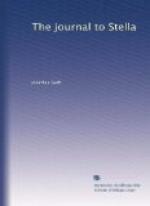2 Sir Andrew Fountaine’s (see Letter 5, note 28) father, Andrew Fountaine, M.P., married Sarah, daughter of Sir Thomas Chicheley, Master of the Ordnance. Sir Andrew’s sister, Elizabeth, married Colonel Edward Clent. The “scoundrel brother,” Brig, died in 1746, aged sixty-four (Blomefield’s Norfolk, vi. 233- 36).
3 Dame Overdo, the justice’s wife in Ben Jonson’s Bartholomew Fair.
4 See Letter 3, note 5.
5 Atterbury, who had recently been elected Prolocutor to the Lower House of Convocation.
6 Dr. Sterne, Dean of St. Patrick’s, was not married.
7 January 6 was Twelfth-night.
8 Garraway’s Coffee-house, in Change Alley, was founded by Thomas Garway, the first coffee-man who sold and retailed tea. A room upstairs was used for sales of wine “by the candle.”
9 Sir Constantine Phipps, who had taken an active part in Sacheverell’s defence. Phipps’ interference in elections in the Tory interest made him very unpopular in Dublin, and he was recalled on the death of Queen Anne.
10 Joseph Trapp, one of the seven poets alluded to
in the distich:—
“Alma novem genuit
celebres Rhedycina poetas,
Bubb, Stubb, Grubb,
Crabb, Trapp, Young, Carey, Tickell, Evans.”
Trapp wrote a tragedy in 1704, and in 1708 was chosen
the first Professor of Poetry at Oxford. In
1710 he published pamphlets on behalf of Sacheverell,
and in 1712 Swift secured for him the post of chaplain
to Bolingbroke. During his latter years he held
several good livings. Elsewhere Swift calls him
a “coxcomb.”
11 See Letter 7, note 21.
12 The extreme Tories, who afterwards formed the October Club.
13 Crowd. A Jacobean writer speaks of “the lurry of lawyers,” and “a lurry and rabble of poor friars.”
14 See Letter 5, note 10.
15 St. John’s first wife was Frances, daughter and co-heiress of Sir Henry Winchcombe, Bart., of Berkshire, and in her right St. John enjoyed the estates of Bucklebury, which on her death in 1718 passed to her sister. In April 1711 Swift said that “poor Mrs. St. John” was growing a great favourite of his; she was going to Bath owing to ill-health, and begged him to take care of her husband. She “said she had none to trust but me, and the poor creature’s tears came fresh in her eyes.” Though the marriage was, naturally enough, unhappy, she did not leave St. John’s house until 1713, and she returned to him when he fell from power. There are letters from her to Swift as late as 1716, not only doing her best to defend his honour, but speaking of him with tenderness.
16 “Battoon” means (1) a truncheon; (2) a staff of office. Luttrell, in 1704, speaks of “a battoon set with diamonds sent him from the French king.”
17 Edward Harley, second son of Sir Edward Harley, was M.P. for Leominster and Recorder of the same town. In 1702 he was appointed Auditor of the Imposts, a post which he held until his death in 1735. His wife, Sarah, daughter of Thomas Foley, was a sister of Robert Harley’s wife, and his eldest son eventually became third Earl of Oxford. Harley published several books on biblical subjects.




